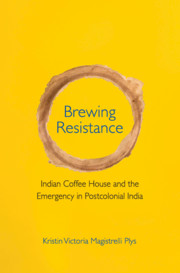Book contents
- Frontmatter
- Contents
- Acknowledgements
- 1 Introduction
- 2 How Anti-Colonial Labour Movements Create Anti-Authoritarian Autonomous Zones
- 3 Indira Gandhi’s Political Economy of Development
- 4 Social Movements of the 1970s
- 5 Emergency at Midnight
- 6 The Coffee House Movement
- 7 ‘Coffee House’ Workers’ Anti-Colonial Labour Movement
- 8 Conclusion
- Appendix I Photographs
- Appendix II Political Parties during the Emergency
- Appendix III Methodological Appendix
- Bibliography
- Index
4 - Social Movements of the 1970s
Published online by Cambridge University Press: 12 May 2020
- Frontmatter
- Contents
- Acknowledgements
- 1 Introduction
- 2 How Anti-Colonial Labour Movements Create Anti-Authoritarian Autonomous Zones
- 3 Indira Gandhi’s Political Economy of Development
- 4 Social Movements of the 1970s
- 5 Emergency at Midnight
- 6 The Coffee House Movement
- 7 ‘Coffee House’ Workers’ Anti-Colonial Labour Movement
- 8 Conclusion
- Appendix I Photographs
- Appendix II Political Parties during the Emergency
- Appendix III Methodological Appendix
- Bibliography
- Index
Summary
thousands of desires, each worth dying for
many of them I have realised, yet I yearn for more
—Ghalib, Hazaaron Khwahishen Aisi (trans. from Urdu)On the eve of the Emergency, four significant, but also quite different, new left movements marked attempts to enact the radical aims of national liberation that, in the two or so decades since Indian Independence, had not yet been realised (Fanon 2002 [1961]: 73): the Naxalite Movement in West Bengal; the Dalit Panthers in Maharashtra; the Bihar Movement; and the Railway Workers’ Strike. These movements both precipitated the Emergency and, in the face of state repression, fomented resistance against the postcolonial state during its period of democratic occlusion. These left movements were accompanied by religious right wing movements: Akali Dal, Jamaat-e-Islami and Rastriya Swayamsevak Sangh. Both the right and left social movements of the 1970s posed challenges to the economic development policies of the Indira Gandhi administration and the social dislocations those policies created (Althusser 1971). In this chapter, I will detail the many social movements that proliferated in 1970s India (Silver and Slater 1999: 207–8) in the lead-up to the Emergency and show how they pushed for the more radical aims of national liberation that had not yet been realised by the 1970s and challenged the policy programmes of the Gandhi administration.
Formation of the CPI(ML) and CPI(ML)-Liberation
The split in the Communist Party was just one of many factionalisations that occurred among the Indian left in the 1960s. The Naxalite Movement and its political party, the Communist Party of India (Marxist-Leninist) (CPI[ML]), was formed as a social movement in the village of Naxalbari in West Bengal in 1967, led by CPI(M) cadres inspired by Maoism, and then became an independent political party in 1969 (Dasgupta 1973, 1974; M. Kumar 2012: 2; P. Singh 2006). The party was formed because of a perception among the leaders of the Naxalbari uprising that the CPI(M) was not committed enough to the peasants’ struggle (Banerjee 1980: 121, 131). The Naxalite Movement, like the Socialist movement, began with an orientation towards the social position of peasants in rural India, though it was not without an urban expression.
- Type
- Chapter
- Information
- Brewing ResistanceIndian Coffee House and the Emergency in Postcolonial India, pp. 80 - 130Publisher: Cambridge University PressPrint publication year: 2020

